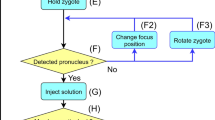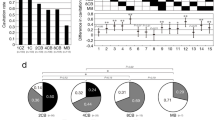Abstract
THE transfer of nuclei from embryonic or differentiated cells into eggs is the most sensitive method of testing whether those nuclei change irreversibly during development. However, among the metazoa its use has been restricted to amphibians and insects1,2 because of problems associated with the microsurgery of the very small and delicate mammalian egg. A few attempts have been made to introduce somatic nuclei into unfertilised mouse oocytes or blastomeres with the help of virus-mediated cell fusion3–7, but the fate of the transplanted nucleus has not been followed beyond the cleavage following the operation. The transfer of nuclei from morula cells both by virus-mediated fusion and by microsurgery has been reported in the rabbit8, the evidence suggesting that such eggs can very occasionally develop to the morula stage. I describe here experiments involving a technique developed independently for use with mouse eggs. After transfer of nuclei from morula cells to fertilised one-cell eggs, more than 25% of the surviving eggs incorporated the donor genome and developed as tetraploids to the morula or blastocyst stage.
This is a preview of subscription content, access via your institution
Access options
Subscribe to this journal
Receive 51 print issues and online access
$199.00 per year
only $3.90 per issue
Buy this article
- Purchase on Springer Link
- Instant access to full article PDF
Prices may be subject to local taxes which are calculated during checkout
Similar content being viewed by others
References
Briggs, R. & King, T. Proc. natn. Acad. Sci. U.S.A. 38, 455–463 (1952).
Gurdon, J. B. The Control of Gene Expression in Animal Development (Clarendon, Oxford, 1974).
Graham, C. F. Wistar Inst. Symp. Monogr. No. 9, 19–35 (1969).
Baranska, W. & Koprowski, H. J. exp. Zool. 174, 1–4 (1970).
Bernstein, R. M. & Mukherjee, B. B. Nature 238, 457–459 (1972).
Bernstein, R. M. & Mukherjee, B. B. Devl Biol. 34, 47–65 (1973).
Lin, T. P. et al. Nature 242, 47–49 (1973).
Bromhall, J. D. Nature 258, 719–721 (1975).
Modlinski, J. A. J. Embryol. exp. Morph. 35, 897–905 (1975).
Snow, M. H. L. Nature 244, 313–315 (1973).
Snow, M. H. L. J. Embryol. exp. Morph. 34, 707–721 (1975).
Tarkowski, A. K. et al. J. Embryol. exp. Morph. 41, 47–64 (1977).
Whitten, W. K. Adv. Biosci. 6, 129–139 (1972).
Tarkowski, A. K. Cytogenetics 5, 394–400 (1966).
Luthardt, F. W. & Donahue, R. P. Expl Cell Res. 82, 143–151 (1973).
Siracusa, G. & Vivarelli J. Reprod. Fert. 43, 567–569 (1975).
Author information
Authors and Affiliations
Rights and permissions
About this article
Cite this article
MODLINSKI, J. Transfer of embryonic nuclei to fertilised mouse eggs and development of tetraploid blastocysts. Nature 273, 466–467 (1978). https://doi.org/10.1038/273466a0
Received:
Accepted:
Published:
Issue Date:
DOI: https://doi.org/10.1038/273466a0
This article is cited by
-
The ups and downs of somatic cell nucleus transfer (SCNT) in humans
Journal of Assisted Reproduction and Genetics (2013)
-
Replication of somatic micronuclei in bovine enucleated oocytes
Cell Division (2012)
-
Histone hypomethylation is an indicator of epigenetic plasticity in quiescent lymphocytes
The EMBO Journal (2004)
-
Mammalian cloning: advances and limitations
Nature Reviews Genetics (2000)
Comments
By submitting a comment you agree to abide by our Terms and Community Guidelines. If you find something abusive or that does not comply with our terms or guidelines please flag it as inappropriate.



